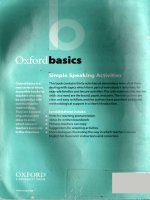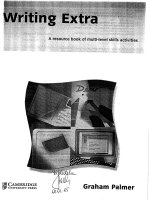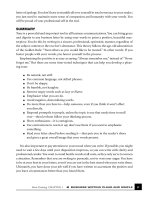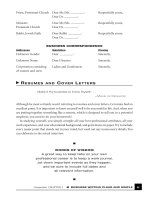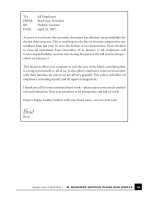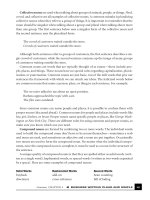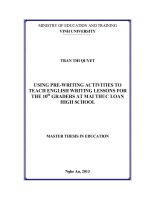Basics simple writing activities
Bạn đang xem bản rút gọn của tài liệu. Xem và tải ngay bản đầy đủ của tài liệu tại đây (4.8 MB, 72 trang )
basics
Jill Hadfield
CharlesHadfield
Oxfordhasics
SimpleWriting
Activities
ITLL H A D F I E L D
C H A R LE S HA DF I E L D
OXJ.ORD
IJNIVERSITY
PRESS
Contents
Foreword
AL AN
M AL EY
Introductlon
L
Actlvities
Greetingsand introductions
2
The alphabet
3
Numbers
4
Tellingthe time
5
Personalinformation
6
Countries
7
Nationalities
8
Locatingobjects
9
Feelings
10
Families
tL
Colours
L2
Shapes
13
Partsof the body
L4
Describingpeople
15
Clothes
16
Rooms
L7
Furniture
18
In town
19
Directions
20
In the market
27.
Shopping
22
Foodand drink
23
Leisureactivities
24
Daily routines
25
26
lobs
Housework
27
Abilities
28
Rules
29
Describingactions1
30
Describingactions2
Foreword
There is a formidable range of materials published worldwide for
teachersof Englishas a ForeignLanguage.However,many of
thesematerials,especiallythosepublishedin English-speaking
countries,assumethat teachersusing them will be working with
smallish classesand have abundant resourcesavailableto them.
Also many, if not most, of thesematerials make implicit
culturally-biasedassumptionsabout the beliefsand valuesof the
teachersand learners.
This situation is ironic in view of the fact that the vast majority of
Englishas a ForeignLanguageclassroomsdo not correspondat all
are large,resourcesare
to theseconditions.Tlpically, classes
limited, and teachershavevery few opportunitiesfor training and
professionaldevelopment.Also, the cultural assumptionsof
teachersand learnersin many parts of the world may vary quite
significantlyfrom thoseof materialswriters and publishers.
This book is an attempt to addressthis situation.The authors
presentthirty lessonsat elementarylevel,eachwith the same
methodological framework. The lessonsare explained in clear,
accessible
language,and none of them require sophisticated
resources.Instead,they call on the basichuman resourceswhich
all teachersand learnersbring with them to class.The language
points coveredare onesfound in a typical elementarycourse,and
the topics are those which form part of everybody'sdaily lives,for
example,families,homes,and leisureactivities.
Most importantly, however,the book offers a framework for
teacherswho lack training and support.The hope and the
expectationis that such teacherswill begin by following each step
will
of a lessonquite closely,but, astheir confidenceincreases,
presented
responding
to the
here,
adapt and add to the techniques
particular needsand abilitiesof their learners.
This is an important book: one of the few attempts to addressthe
problemsof the'silent majority' of teachersworldwide who have
little or no training, and few resourcesto work with.
AL AN
M AL EY
Assumption University
Bangkok,Thailand
lntroduction
Englishis taught all over the world, by all sorts of teachersto all
sortsof learners.Schoolsand classroomsvary enormouslyin their
wealth and their provision of equipment.Learnersarevery
different from placeto place.But, whateverthe conditionsin
which you are working, there is one resourcewhich is universal
and unlimited: the human mind and imagination.This is
probablythe singlemost valuableteachingand learningresource
we have.Nothing can replaceit. In eventhe most'hi-tech'
environment,a lack of imagination and humanity will make the
most up-to-dateand sophisticatedresourcesseemdull;
conversely,
the most simple resourcescan be the most exciting
and useful.
We havebeen fortunate to spendquite a lot of our time working
not only in hi-tech environmentswith computersand video,but
alsoin classroomswhere there is little more than blackboardand
chalk and someout-of-datecoursebooks.Someof our most
interestinglearningand teachingexperiences(asConfuciussaid,a
teacheris'alwaysreadyto teach;alwaysreadyto learn') havebeen
not in the comfortablewell-resourcedsmall classroomsof a
privatelanguageschool,but in classroomswhere only the
minimum of equipmenthasbeen available.Equally,someof our
most memorableteachingexperiences
in'hi-tech' classroomshave
beenwhen we haveabandonedthe cassetteor video or glossy
coursebookand got to work with that most preciousresourceof
all, the learners'ownexperienceand imagination.
Teachersoften haveto usematerialswhich are out of date,or
contain subject-matterirrelevantto their particular group of
learners.For example,we havehad greatdifficulty explainingthe
conceptsof the fridge -freezerand microwave oven to Tibetans.In
the sameway,learnerswho havespentall their livesin northern
countries might have difficulty with an exercisefrom an African
textbook which asksif they preferyam or cassava.
So over the last
few yearswe havebeen trying to designmaterialswhich can be
usedin aswide a rangeof teachingsituationsaspossible.
The activitieswe suggestare asflexible asthe human imagination is
creative;they are'teacherresourcematerial'which teacherswill be
ableto adjust to suit their particular environment.In thinking about
universallyapplicable,'lo-techmaterialswe havecome up with a list
of criteria that needto be met. The materialswill needto:
be usablein largeclasses
aswell as small.
be suitablefor adult learnersaswell as secondarylearners,and if
possibleeasilyadaptableto a primary context.
be centredon the universalsof human experience.
cover the main languageskills and have a useful baseof grammar
and topic vocabulary.
Introduction
be traditional enoughto be recognizableto all teachers,and thus
give them a senseof security,while providing communicative
activitiesfor learners.
be non-threateningin the demandsthey make on learners.
material'rather than books for learners.
be teacher-based'resource
assumethat no technicaland reprographicresourcesare available,
and be basedon the human resourcerather than the technical.
be culturally neutral,not context-bound,and thus flexibleand
easilyadaptableby the teachersto their own culture and teaching
context.
be flexibleenoughto complementa standardsyllabusor
coursebook.
SimpleWriting Activities
This book containsthirty activities,designedaccordingto the
criteria above,for developing the writing skill at elementarylevel.
Eachactivity has three main stages:
Lead-in-This introducesthe learnersto the topic, and focuses
their attention.
Organizingtexts-This stageprovidescontrolledwriting practice
in preparationfor a freer writing task.
Creating texts-This stagegivesthe learnersthe opportunity to
usethe knowledgethey haveacquiredin the previoustwo stagesin
producing their own text. The teacherprovidesa contextand a
reasonfor writing.
Lead-in
aaaaaaaoaaaa*aaoaaaar aaa
Organizingtexts
Writing is easierif the learnersare preparedfor the task,and if
their imaginationsare stimulatedbeforehand.The purposeof the
lead-in is to'warm up'the learners,in other words,to start them
thinking about the topic and practisingsomeof the languagethat
will be neededwhen they actuallycome to write.
aaaaaaaaaa
The aim of this stageis to give the learnerscontrolledwriting
practicebeforethey attempt a freer writing task.This is important
becausethe languageof writing is different from that of speech.In
speech,utterancestend to be short or incomplete,and the
languageusedis often colloquial,and may break grammatical
rules.However,most written languageis more formal and
elaborate,and follows certain conventions.
The text organizationtechniquesusedin this book are as follows:
Introduction
Completion-The learnersfill in the blanks in a text or a
crosswordpuzzlewith an appropriateword or phrase.This
techniquecan give learnerspracticein a particular languagepoint,
for example,placeprepositions.
Describinga picture-The learnerswrite a descriptionof a
picture.They may then discussthe best order in which to describe
the different elementswhich go to make up the picture. This gives
them practicein organizinga spatialdescription.
using a linking word,
foining-Learners join words or sentences
such as'and'or'but'. This techniquehelpslearnersto developthe
skill of linking ideaslogically and writing more fluently.
Matching-The learnershave to match the two separatehalvesof
sentences
which are written in the form of two lists.This technique
helpslearnersto understandhow sentences
are constructedand
which words can go with other words.
Reordering-Sentencesor textsare givento the learnersin
muddled order and they haveto rearrangethem in the correct
order.Reorderingsentences
is usefulfor teachingword order,while
reorderingtextshelpslearnerspractisechoosinga logical sequence
for sentences.
Substitution-In this techniquea basicsentenceframework is
written on the board. The learnercan vary this by choosing
differentwords or phrasesat certainpointb.This showslearners
how a basicsentenceform may be usedwith slight variationsto
expressa number of different meanings.
Writing from notes-The learnersare given notes to expand into
text. This givesthem practicein arrangingtheir ideascoherently.
Greatingtexts
It is difficult to write when you don't know who you are writing to,
or why. In real life we alwayshave a reasonfor writing: for
example,to answera letter,preparea shoppinglist, or make notes
for a talk. In the classroomthere is often no apparentreasonfor
writing beyond'The teachersaid do this for homework'.If,
however,you provide the learnerswith a context for creating a
written text, you can make the task much more concreteand
interesting.There is a wide variety of techniqueswhich you can
use.The oneswe haveusedin this book are as follows:
.
Writing from a picture-The learnersusea picture as a startingoff point for creatinga text.
:i: Responding to a text-The learnersare given a text to read before
they write, for examplea poem or a letter.The text actsas a source
of inspiration,and usefulwords and phraseswhich they can usein
their own writing. Alternatively, they may be askedto use their
lntroduction
own textsfrom the'Creating texts'part of the lesson.
Surveyand report-In this techniquethe writing task is preceded
by a speakingtask in which the learnershaveto gatherinformation
from eachother and useit to write a report. This givesthem
somethingconcreteto write about, and a definitepurposein
writing.
Visualization-The learnersclosetheir eyesand visualizea scene
which you describeto them. They then write about the scenethey
have imagined. They may sharewhat they havewritten with
anotherlearner.
Learnerscan alsoact as eachother'saudience.This is the most
immediateand direct way of providing the writer with a reader.
There arevarious techniqueswhich can be used:
Write and do-The learnerswrite texts,for example,a letter,a
seriesof instructions,or a descriptionof a scene.Other learners
read them and respondin an appropriateway,for exampleby
creatinga tableauof the scene.
Write and draw-The learnersdraw a picture and write a
descriptionof it. They either passtheir descriptionto another
learnerwho has to draw a picture of it, or the picturesand
descriptionsare put up in the classroomand the learnersmatch
them.
Write and guess-The learnerswrite a descriptionor riddle for
othersto read and guessthe personor object being described.
Teachersoften setwriting for homework,and someof the
activitiesin this book may be given for homework if time is short.
However,they are really designedto be done in class,so that you
can circulatewhile the learnersareworking, supply any vocabularlthey need,and corrector explainany mistakesas they arise.It is
also an advantagefor learnersto receiveimmediate feedbackfrom
one another on their writing.
Materials
A wide variety of text typesis usedin this book. Theseinclude
descriptions,narratives,reports,instructions,lists,poems,and
letters.This helpsto provide interestand equipsthe learnersto
deal more effectivelywith different kinds of writing.
Many activitiessuggestthe useof a poster.This is simply a text
written out in largeletters,or a picture,on a big sheetof paper.If
you preparepostersbeforethe lesson,it meansthat you do not
havethe time-consumingtask of writing or drawing on the board
while the lessonis in progress.This is a particular advantageif you
are not very confident about your drawing skills.It also meansthat
Introduction
you will not haveto write out the text, or draw the picture, again
the next time you want to useit.
Ifyou decideto useposters,try to find a cheapsourceof sheetsof
paper.In Madagascar,for example,the teacherswe worked with
found the sheetsof paper usedfor wrapping vegetablesin the
market were ideal for making posters.A good way to fix postersto
the board is to pin a length of string along the top of the board like
a clothes-line.You can then useclothes-pegsto pin your postersto
the string!
An alternativeto drawingson postersis drawingson smallerpieces
of card (but still largeenoughfor all the learnersto see).Theseare
usuallyknown as'flashcards'.
They are usedin 1l 'Colours' and 24
'Daily routines'.
Gorrection
After someof the activitiesyou will want to correctthe learners'
work in order to give them feedbackabout their progress.It can be
very discouragingfor learnersif their work comesback coveredin
red ink, and this can have a destructive effect on their creativity,
enthusiasm,and confidence.In addition, if everymistakeis
correctedby the teacher,this robs the learnerof a valuablelearning
experience-how to spot and correcttheir own mistakes.You can
reducethe'big red pen' effect,and help learnersto self-correctby
using the following strategies:
Working with learnersas they are writing, supplying vocabulary
and pointing out mistakes.
Getting learnersto work togetheror read eachother'swork and
help eachother with mistakes.
When you correctlearners'work,usesymbolsin the margin to
indicatethat there is a mistakein that line rather than correcting
the mistakeyourself.It is then up to the learnerto work out what
waswrong, and what the correctversionshouldbe. Usefulsymbols
are:
well done
o
organization
Sp spelling
T
tense
Pr preposition
WO word order
lntroduction
A
article
Ag
agreement(singular/plural,etc.)
P
punctuation
V
vocabulary
Gr
other grammar mistake
You may not want to correcteverymistakein a learner'swork, but
preferto concentrateon one specificareaat a time, for example,
tenses,spelling,or prepositions.If you adopt this systemyou will
need to givelearnersa little time after you hand back their writing
tasksto work out what was wrong, write in the correct version,
and askyou for help if they still do not understand.If most of the
classmade the sameor similar mistakes,you may want to devotea
lessonor part of a lessonto remedialwork on this area.
Buildinga lesson
There are four companion books to this one,PresentingNew
Language,SimpleListeningActivities,SimpleSpeakingActivities,
and SimpleReadingActivities.AII of thesealso contain thirty
activities,and in all five books the topics and the language
presentedand practisedcorrespond.So,for example,activity I in
all five books is about'Greetingsand introductions' and activity 30
is about'Describingactions'.The activitiesin eachbook are
graded,following a basicstructural syllabus.This meansthat you
can designyour own lessonor sequenceof lessonsusing material
from any,or all, of the books,dependingon your learners'needs
and the time available.
Activities
Greetingsand introductions
L ANGUAGE
Organizingtexts:completion.
Creating texts: writing from a picture.
T E C HNIQUES
The dialoguebelow; the picturesbelow,on postersor on the board.
MAT ERIAL S
Preparethe posterif you are using one.
P R E PARAT ION
TIME
Hello. My name's
What's your name?
Nice to meet you.
GUIDE
Lead-in
30 minutes.
Walk around the classintroducing yourself to the learners.Use
'Hello. My name's
What'syour name?'
Put up thesepictures.
Hello. Mg namos Be"ur. Mq noru"ts Kak .
" Niceto neefgort.
\itr."tb3our yron€,?
Ni."to \
\- +ooY
l- mecl- uorr
Tell the learnersto repeatthe dialogue.Then cover,or rub out, the
names,and get the learnersto repeatthe dialogueagain,using their
own names.
Organizingtexts:
completion
3
Write this gappeddialogueon the board:
FEN Hello.
KATE My name'e
FEN
Lo -you
Oen.-your
Nice-
?
meeN-.
Loo.
Ask the learnersto copy the dialogueand fill in the gaps.
Greetingsand introductions
Cleatlng texts:
writing fiom a picture
a aa aa aa ao ea aaaaa
Gomment
4
When everyonehas finished, write in the missing words on the
board and get the learnersto checktheir work.
5
Put up thesepictures.Getthe learnersto copythem and to write in
the dialogue.
6
Ask one or two pairs of learnersto read out their sentencesinthe
correct order, one taking Ben'spart and the other Kate's(get them
to usetheir own namesif they prefer).
aaaaa a t a a a a a a a a a a a a a a a o t a a a a t a
If appropriate, changethe namesto more familiar local names.
LANG UAGE
TECHNI QUES
MATERIALS
P REPARATION
TIM E GUIDE
raa aaat aaaaaaa
Organizingtexts:reordering.
Creatingtexts:writing from a picture.
Thejumbledwordsbelow;the picturesbelow,on a posteror on the
board.
Prepare
theposterifyou areusingone.
40 minutes.
aaaaaaaaaaaaa
aaaaaa t a a a o o n a a a a
Lead-in
Thelettersof the alphabet.
7- Spellout this dialogue(i.e.pronounceeachletterseparately):
H-e-l-l-
n
W-h -a -l'-s
M-y
M- y
n-a-m-e' -
y-o-u-r
n-a-m-e'-e
D-e-n.
n-a-m-e?
K-a-t,-e.
y-o-u.
N- i- c -
Tellthe learners
to put up theirhandandtell the classwhenthey
guessa woro.
aa aaaaaeaaaaaaaaaaaaaaaaat a a
texts:
Organizing
aaaaaaaaaaaaaonaao
2
leoldeling
Write theseiumbledwordson theboard:
LOLHE
CEIN
NEF
TEME
N/EAN'9 OT
YM
OYU
AMNE
TEKA
YM
UYOR
g'THWA E9'MNA
3
10
Dividethe learnersinto pairs,A andB.AskA to look at the
iumbledwordsin the first columnandto sort themout. B shoulc
do the samefor the secondcolumn.
Thealphabet
Creatingtexts:
wdting fiom a pictule
4
When they have finished, askA to dictate his or her words to B,
who should write them down. Then get B to do the samefor A. Tell
them to make a dialogue from the words.
5
Put up thesepictures:
6
Tell the learnersto copy the pictures and write the dialogue in the
sPaces.
Get learnersto compare their dialogueswith others in the class.
Gomment
Learnerscan write their own dialoguesusing different names,and
dictate them to one another.
l1
Numbers
L ANGUAGE
Numbers.
Organizingtexts:completion.
Creatingtexts:respondingto a text.
T ECHNIQUES
M AT ERIAL S
PREPARAT ION
TI M E G UI DE
The crosswordbelow a blank versionwith cluesand a versionwith
answers,on two posters;the poem below,on a posteror on the
board; examplesof the objectsin the poem.
Adapt the poem if necessary.
Make the crosswordposters,and the
poem posterif you are usingone.
Collect examplesof the objectsin the poem.
50 minutes.
Lead-in
1,
Give the learnerssomesimple'mental arithmetic'with numbers up
to 20. For example,ask them to add 6 and 4, and t8 and 2. You
could make this into a competition betweentwo teamsif you like.
Organizingtexts:
completion
2
Put up the blank versionof the crossword.Make surethat the
learnersunderstandhow to fill in a crossword.
3
Tell the learnersto copy the grid, but not the clues.
4
Ask them to completethe crosswordon their own, and then
comparetheir answersin pairs.
Across
1 6x2
4 b+11
5 1+2
7 b-7
O 3x5
I 3x3
12 20-3
15 6x3
16 7x2
Down
1 16-3
2 1O+1
3 3+4
5 5x2
6 3+2
10 4xZ
11 1Ox2
12 12-6
15 BxZ
14 7-5
16 2x2
Put up the versionwith answers.
T2
Numbers
aaaaaoaaaa
a a a ta a a a a a a a a a aaaaaaaaaaaaaaoa
Creatingtexts:
respondingto a text
6
Put up this poem. (If necessary,
changesomeof the objectsto
thoseyour learnersare more likely to havein their schoolbags.)
ln 1am's echoolbag
ONEEnqliehbook,
MO woodenrulers,
THREEclaee nolebooke,
FOUKblackpene,
FIVEchocolaLebiscuits,
1lX paVerhankiee,
9EVENpoVcaoeettee,
EIGHTcoloured?encile,
NINEbus tickeL6,
TEN oiicky sweels,
Show the classan exampleof eachobject in the poem, and askthe
learnersto identifr it. Tell them they may use their own languageif
they don't know the word in English.
7
Readthe poem, holding up an exampleof eachobject asyou read
eachline.
I
Get the classto read the poem in chorus.Then ask for a volunteer
to come out and hold up eachobject asthe rest of the classread
the poem.
9
Ask the learnersto tell you about other things they have in their
schoolbags.Tell them they may usetheir own languageif they don't
know the word in English.Translatetheir suggestionsinto English
and write them on the board.
10
Ask the learnersto write a poem like'In Sam'sschoolbag',called'In
my schoolbag'.
l3
Tetting
thetime
4
LANGUAGE What time is it?
It's -
o'clock.
Numbers.
rECHNreuEs
Organizingtexts:completion.
Creating texts: responding to a text.
MATERIALS Notes and clock faces,on postersor on the board; diary pages,on a
posteror on the board.
pREIARArroN
Ifnecessary,adapt the notesto suit your learners'agesand cultures.
Preparethe postersif you are using them.
TrMEGUrDE 40 minutes.
Lead-in
L
Revisetimes by drawing a clock face on the board, drawing in the
hands at different times, and asking the learnersto tell you what
time it is. Use:
What time is it?
It's -
Organizingtexts:
completion
2
o'clock.
Put up thesenotesand clock faces:
)ue, seeyou afuer schoolaN-.
Tom
Helen,meeNyou
allhe cinemaaf,-.
Tom,meetrme lor lunchaN
. Helen
ie atr-.
Jamee,the meeNinq
)ue
James
6
T4
Telling
the time
i6t
(If necessaryteach'see','school','meet','cinema','lunch',
and
'meeting'.) Tell the learnersto match the notes and the clock faces.
3
Get the learnersto copy the notes and write in the times in words.
4
Check the answerswith the whole class.
5
Put up thesenotes:
1am, Tom,-you
)ue, Helen,Lhe
Creatingtexts:
respondlngto a text
youatthe -
at eiqhNo'clock.Tom.
afLer
me for
aNfour o'clock.)ue.
at lwelvefitleen. Helen.
ie al ten lhirty. Mark.
6
Ask the learnersto copy the notes and fill in the gapswith
appropriate vocabulary items from the first set of notes.
7
Check the answerswith the whole class.
I
Put up thesediarypages:
Meet 1am. TeaaeueCinema.Film-b.l5.
Meelina-3.2O. TellTom.
Dinnerwilh James.HuanaShan reslauranN
-7.30.
Arranqelo 6ee 7ue after work-6.OO
CasablancaCafe.
Tell the learnersto write notes to Sam,Tom, Iames,and Sue
making thesearrangements.
Ask some learnersto read out their notes to the whole class.
15
tlA
Personalinformation
J
LANGUAGE My nameis -.
Iam-.
Iama
I am from
I live at
My hobbies are TEcHNreuEs
and -.
Organizingtexts:reordering.
Creating texts: responding to a text.
MATERTALS Jumbledsentences;
letter,on a posteror on the board.
IREIARATToN Preparethe posterif you are using one.
TrME GUIDE 40 minutes.
Lead-in
L
Ask the learnersif they have,or haveeverhad, a penpal.Ask some
questionsabout their penpals,for example:
What is his or her name?
Where is he or shefrom?
aaaaaaa t a a
aaaaaaaaaaaaaaaaaaaaaoaaaaaaaa
Organizing texts:
reoldering
2
Write thesejumbled sentences
on the board:
namemy Johnie.
liveI aN79 AbbeyKoad
)eneqalfrom I am
learnera l'm
15l am
hobbies
are my dancinqowimminq
and
Tell the learnersto write them out correctly.Remind them that
eachsentenceshould begin with a capital letter and end with a full
stop.When they havefrnished,get them to comparetheir answers
in pairs.
3
16
Ask individual learnersto read out their answersto the whole class.
Personal
information
aa a aa aa taa aa aa aaaaaaaaaaaalaat aoaaaat aaaa a a a o a
Gleating texts:
4
Put up thisletter:
respondingto a text
DearVenpal,
LeLme inf,roduce
myoelf.
l'm 2l yearoold.
My name'e1anjayJhabvala.
I'mfrom lndia.
l'm a poolman,
I liveaN25 City Koad,Delh|
My hobbieeare cyclin4and football.
Wrile and tell me all aboul youreelfl
Ask the learnersto rewrite the letter, putting the sentencesin a
better order (name,age,country,address,job, hobbies).Draw the
letter layout below on the board and tell them to follow it.
When the learnershave rewritten the lettet ask them to write a
reply, telling the penpal all about themselves.
T7
^
r\-/t
Gountries
LANGUAGE 'Countries'(for example,India, Greece,fapan) and'food' (for
example,curry, pizza, hamburgers) vocabulary areas.
- is/ are from -.
rEcHNreuEs
Organizingtexts:substitution
Creating texts: responding to a text.
MATERTALS Substitutiontable,on a posteror on the board; menu, on a poster
or on the board.
pREpARArroN Preparethe postersif you are using them.
TrME GUrDE 40 minutes.
Lead{n
1,
Ask the learnersif they have ever tried any of the fbllorving: curry,
pizza,hamburgers,sushi,or chop suey.Ask them if thev know
which countriesthesekinds of food come from.
Olganizing texts:
2
Put up this substitutiontable.
substitution
Tizza
ta
Chopeuey
are
from
lndia.
Greece.
Voueeaka
Ja?an.
Goulaeh
Italy,
lamburqero
China.
Curry
Hunqary.
Suehi
the U)A.
3
Tell the learnersto match the countries rvith the kinds of food, and
then write sevencorrect sentences.
4
Check the answerswith the whole class.
6;;;il;;'i;i;;'''''''''''';'';;; ;; ili,;;;,,
respondlng to a text
TNTERNATTO\,A,,
<=3-irRANT.
webomeNo TheRENDEZVOU9
Fromltaly,try our taoty Vizzae.From)wilzer.a.a, ne vrinqyou
A epecialilyfrom
fondue.FromGreece,moussaka.
Mmm.Oelicic-e.
Turkey,kebabe.Andfrom Thailand,epicyf'eh curry.
18
Countries
Explain any new vocabulary for example,'tasty','fondue','delicious',
'speciality','kebab',
and'spicy'.
Put the learners in pairs and ask them to discusshow they would
lay out the menu to make it read and look better. Go round and
help them while they are doing this.
Collect suggestionsfrom the classand write up a new more
attractive menu on the board. Ask the learnerswhat they would
chooseto eat.
I
Put the learners in groups of three or four and ask them to design
their own international menu.
When they have finished, get them to swap menus. Each group
should then discusswhat they would choosefrom their new menu.
Write thesespeechbubbleson the board if you think they need
suPport:
Mmm.lthink l'lllry -.
Whal about you?
eoundsdelicioue.
aa aa aa aa aa aa aaaaaaaaaaaaaaaaaaaaaoaaaa a a a a a l a a
Comment
If appropriate,changefood items and their countriesof origin to
suit your learners'cultureand generalknowledge.
t9
Nationalities
LANGUAGE 'Countries'(for example,Canada,fapan, China) and'nationalities'
(for example,Canadian, fapanese,Chinese) vocabulary areas.
TEcHNreuEs
Organizingtexts:completion.
Creating texts: responding to a text.
MATERIALs Lists and sentences,
on a posteror on the board; letters,on a poster
or on the board.
eREIARATIoN Preparethe postersif you are using them.
TrME GUrDE 40 minutes.
Lead-in
1,
Ask the learnersabout the nationalities of famous people they are
likely to know; for example,pop stars,sportsmen and women, and
political leaders.
Otganizingtexts:
completion
2
Putup threelists,for example:
Country
Nationality
Languagea
Canada
Japan
China
Mexico
)witzerland
Thailand
Venezuela
Morocco
Rueeia
Venezuelan
9wise
Canadian
Thai
Japanese
Kueeian
Moroccan
Chinese
Mexican
French,
German,and ltalian
SVanieh
)oanish
Frenchand Enqlieh
Chineee
Frenchand Arabic
Kussian
Japanese
Thai
fuk the learnersto match country nationality, and languages.
3
Put up some gap-fill sentenceslike the ones below Tell the learners
to copy them, filling in the gapswith words from the lists:
Carlosis -.
He comeefrom Acapulco.
9u RonqRonqie
Aeqoniois a -.
He liveein Caracae.
Jameoie a -from
Maria ie
ana _.
Monlreal.He opeako-
and -.
and comeofrom Luqano.She opeako
Jamilais -,from
20
the livesin Shanqhai.
Marrakech.)heepeaks
and -.
Nationalities
Creatingtexts:
respondingto a text
4
Put up theseletters:
Hil
I likemusicand frlme.I soeak
and -.
yeare
My name'oJean.l'm23
old.I'mCanadian.
I liveat 26
Avenuede Ternes,Vontreal.Howaboul vou?Lel me inlroduce
mveelf.
Hellol
I livein thanqhai,a biqcily in the easl of -.I'm
Chineee.
My hobbieo
readin4
are
and badminton.
I likeEnqliohlI opeak
Vy name'eeonq Lin.Howabout
and a little Enqlieh.
vou?
Explain that the sentencesin both letters are in the wrong order.
Go through the first one with the whole class,asking the learnersto
reorderthe sentences.
Get them to do the samewith the other letter, working on their
own.
Ask for volunteersto read out their lettersto the rest of the class.
Suggestcorrectionsif necessary.
Ask the learnersto chooseone of the two letters and write a reply
to it. They can use languageand sentencepatterns from the letters
to help them.
aataeaaaaaaaaaaaa
Gomment
If you feel that your learners are not familiar with the ones
prese.rt"d here, substitute different countries and nationalities, and
adapt the letters.
21

